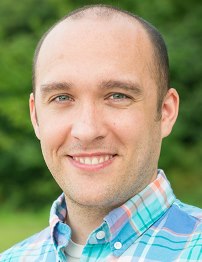
- Dugan Hayes
- Beaupre 374E
- Associate Professor
- (401) 874-5516
- Ph.D. The University of Chicago
- dugan@uri.edu
Research summary: Global human power consumption represents less than 0.2% of the solar power incident upon Earth, but this clean, renewable resource remains drastically underexploited. Improving the function of solar energy conversion devices made from durable, earth-abundant materials is necessary to make solar technology an integral part of a clean, renewable energy strategy. Energy conversion in photovoltaic and photocatalytic materials begins with the formation of excitons and/or free carriers, and the fates of these transient species – whether or not they can be separated and extracted before they recombine – is what ultimately determines conversion efficiency. Thus, a thorough understanding of the dynamics of charge separation, migration, and recombination on timescales ranging from femtoseconds to microseconds is crucial for guiding the design of next-generation materials. To this end, our group employs a variety of cross-regime ultrafast transient absorption spectroscopies to characterize these dynamics. In such measurements, a laser “pump” pulse synchronously launches light-induced processes in an ensemble and a subsequent “probe” pulse reports on the state of the system at a later time. By combining ultrafast optical, terahertz, and X-ray pulses in different experimental configurations, we can probe a broad manifold of transient chemical and physical properties of materials as they evolve during photochemical or thermochemical processes. Collectively, the insights gained from these techniques give a picture of how and why solar energy conversion materials work and what properties could be targeted to improve performance. Our work is carried out both in the laser lab and at large-scale X-ray user facilities.
